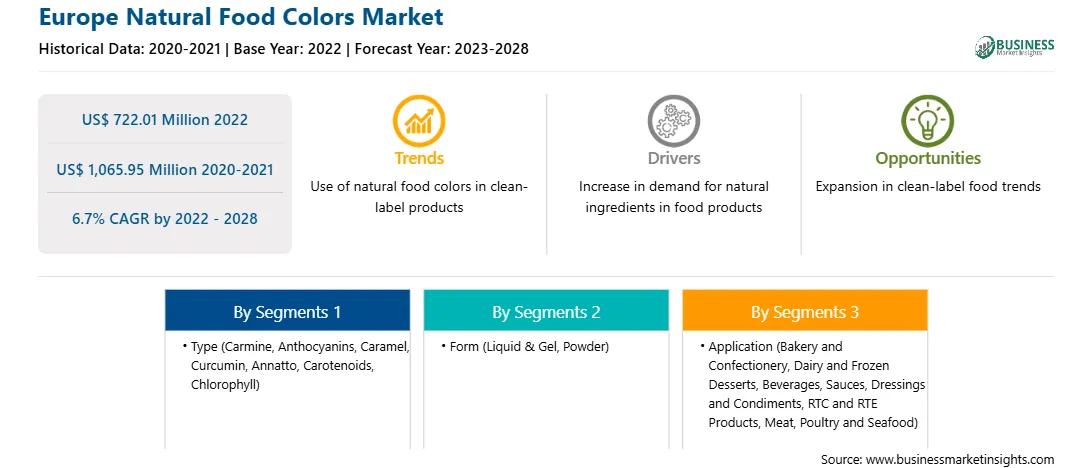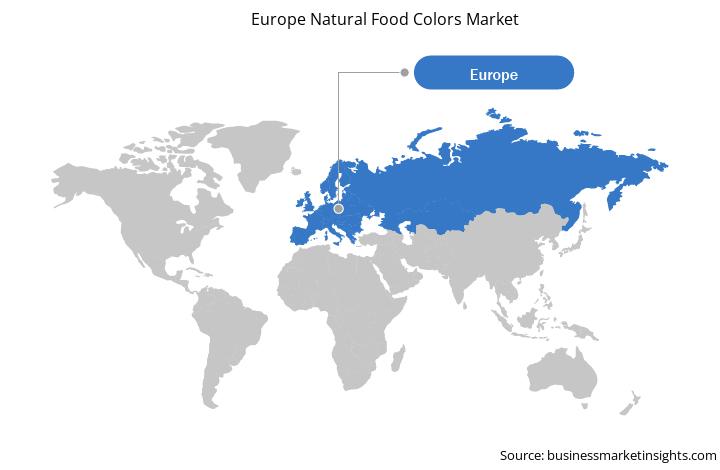The natural food colors market in Europe is expected to grow from US$ 722.01 million in 2022 to US$ 1,065.95 million by 2028. It is estimated to grow at a CAGR of 6.7% from 2022 to 2028.
Rising consumer concerns about synthetic ingredients
The food & beverages industry has witnessed significant growth for natural food color, owing to the rising concerns pertaining to the use of synthetic food colors. Food colors are used in both commercial food production and domestic cooking. They are also used in a variety of pharmaceutical applications and cosmetics. Synthetic food colors contain cancer causing, toxic contaminants that result in increased inflammation and disrupts the functioning of the immune system. Several studies suggest that it may also lead to cancerous tumor. Synthetic food colors are of low cost and have an improved and attractive appearance, but they also cause hypersensitivity in children. Furthermore, FDA has also reported synthetic colors to be showing signs of cancer in young children. For instance, in soft drinks, the caffeine is used as a color and it may cause heart problems. Thus, the rising consumer concerns about synthetic ingredients are estimated to drive the market growth of natural food colors.
Market Overview
European countries such as France, Germany, United Kingdom, Italy, Russia along with rest of European countries have increased demand of beverages, especially sports drink, as a result of rising athletic activities and population with high disposable incomes. According to the data from International Olympic Committee, Europe (Russia, France, Germany Italy, Sweden and Czech) accounts for highest number of athletes (875) representing individual Olympic committees. Moreover, during and post pandemic, the clean label, natural and organic products trend accelerated along with increased utilization of natural colors, flavors and sweeteners. According to Natural Food Colors Food Association (NATCOL), the European consumer request for natural solutions and products containing natural colorants was 62% in 2019-2020. European Commission banned titanium dioxide (E171) as a food additive, as studies show its potential harm to human health. Therefore, food manufacturers are opting for a natural food color alternative of titanium dioxide. These increasing regulatory restrictions on application of synthetic food colors is anticipated to increase innovations and production of natural food colors. Furthermore, according to UNESDA report, the consumption volume of soft drink in the European Union accounted for approximately 46,923.5 million liters. This increasing demand of beverages such as soft drinks, mocktails and sport drinks along with consumer preferences of natural foods is anticipated to grow natural food color market.
Europe Natural Food Colors Market Revenue and Forecast to 2028 (US$ Million)
Strategic insights for the Europe Natural Food Colors provides data-driven analysis of the industry landscape, including current trends, key players, and regional nuances. These insights offer actionable recommendations, enabling readers to differentiate themselves from competitors by identifying untapped segments or developing unique value propositions. Leveraging data analytics, these insights help industry players anticipate the market shifts, whether investors, manufacturers, or other stakeholders. A future-oriented perspective is essential, helping stakeholders anticipate market shifts and position themselves for long-term success in this dynamic region. Ultimately, effective strategic insights empower readers to make informed decisions that drive profitability and achieve their business objectives within the market. The geographic scope of the Europe Natural Food Colors refers to the specific areas in which a business operates and competes. Understanding local distinctions, such as diverse consumer preferences (e.g., demand for specific plug types or battery backup durations), varying economic conditions, and regulatory environments, is crucial for tailoring strategies to specific markets. Businesses can expand their reach by identifying underserved areas or adapting their offerings to meet local demands. A clear market focus allows for more effective resource allocation, targeted marketing campaigns, and better positioning against local competitors, ultimately driving growth in those targeted areas.Europe Natural Food Colors Strategic Insights

Europe Natural Food Colors Report Scope
Report Attribute
Details
Market size in 2022
US$ 722.01 Million
Market Size by 2028
US$ 1,065.95 Million
Global CAGR (2022 - 2028)
6.7%
Historical Data
2020-2021
Forecast period
2023-2028
Segments Covered
By Type
By Form
By Application
Regions and Countries Covered
Europe
Market leaders and key company profiles
Europe Natural Food Colors Regional Insights

Europe Natural Food Colors Market Segmentation
The Europe natural food colors market is segmented into type, form, application and country. Based on type, the market is segmented into carmine, anthocyanins, caramel, curcumin, annatto, carotenoids, chlorophyll, and others. The carotenoids segment registered the largest market share in 2022.
Archer Daniels Midland Company, Aromata Group, BASF SE, Döhler Group, DuPont, Givaudan S.A., Koninklijke DSM N.V., Naturex S.A., Oterra A/S, and Sensient Technologies Corporation are the leading companies operating in the natural food colors market in the region.
The Europe Natural Food Colors Market is valued at US$ 722.01 Million in 2022, it is projected to reach US$ 1,065.95 Million by 2028.
As per our report Europe Natural Food Colors Market, the market size is valued at US$ 722.01 Million in 2022, projecting it to reach US$ 1,065.95 Million by 2028. This translates to a CAGR of approximately 6.7% during the forecast period.
The Europe Natural Food Colors Market report typically cover these key segments-
The historic period, base year, and forecast period can vary slightly depending on the specific market research report. However, for the Europe Natural Food Colors Market report:
The Europe Natural Food Colors Market is populated by several key players, each contributing to its growth and innovation. Some of the major players include:
The Europe Natural Food Colors Market report is valuable for diverse stakeholders, including:
Essentially, anyone involved in or considering involvement in the Europe Natural Food Colors Market value chain can benefit from the information contained in a comprehensive market report.